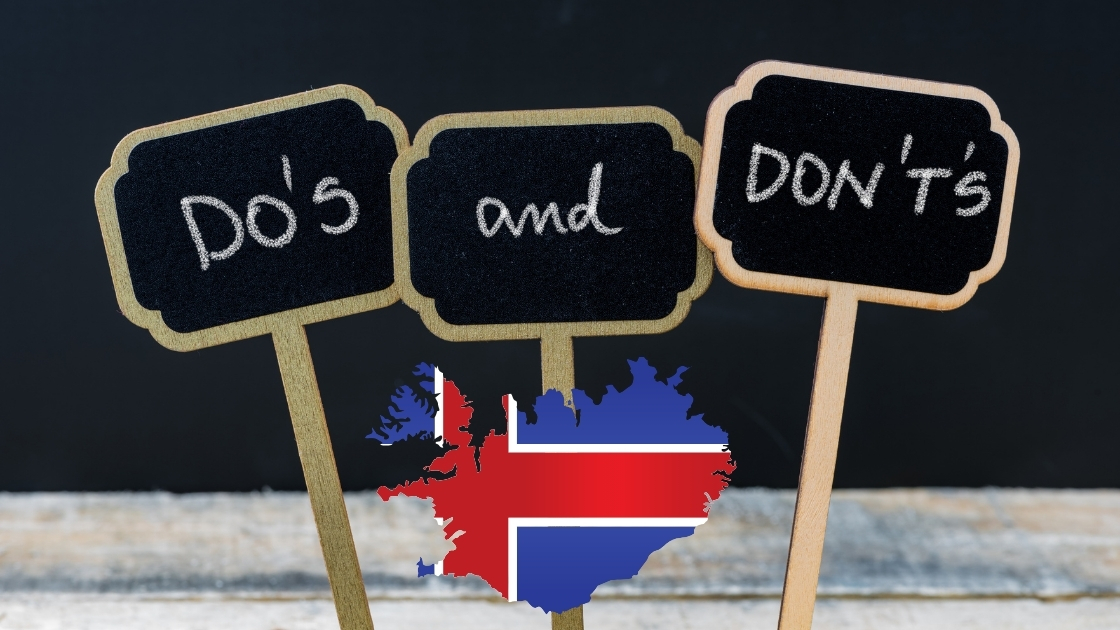

Whether you’re planning your first trip to Iceland or you’ve visited before, knowing the do’s and don’ts can make your experience smoother and more enjoyable. Iceland is a breathtaking country with unique cultural norms, unpredictable weather, and natural wonders that demand respect and preparation.
I’ll walk you through essential travel tips—things you should absolutely do to get the most out of your visit, as well as common mistakes to avoid. From driving safely on Iceland’s rugged roads to experiencing the hot springs like a local, these insights will help you navigate your adventure like a pro. Let’s dive into the essential do’s and don’ts for traveling in Iceland!
5 Do's & Don'ts When Visiting Iceland
1. Do go to local pools, lagoons and upscale spas.

Iceland’s bathing culture is such a big part of life here and it’s lovely to relax in a geothermally warmed hot tub. Most people think that when I say local pool that I mean some run of the mill uninteresting place but in Iceland, the local pools are lovely and budget friendly.
- For instance, the biggest one in Laugardalslaug has several hot tubs, including a saltwater one, an Olympic sized lap pool, a wading pool, a gigantic slide for kids of all ages (meaning adults too), a steam room, sauna, a cold dipping pool and lovely changing area. All of that is accessible at the cost of 1.389 ISK or $9.81 for adults, $1.41 for young adults aged 16-17 and free for children up to the age of 15. Every local pool has its own charm and there is almost 2 dozen just in the Reykjavík capital area and many around the whole country.
- Places like the Blue Lagoon, Sky Lagoon and other well known places to take a dip will cost a lot more. For instance, the Blue Lagoon is 9.900 ISK or about $70 for the lowest admission price for one adult. These places are extremely unique and I have enjoyed many visits to all of the lagoons and new baths around the country, so I don’t discourage going, but just know that you have local options too that are great.
Don’t go into a pool, lagoon, or hot tub in Iceland without showering first
One of the most important etiquette rules in Iceland is showering thoroughly, without a swimsuit, before entering a pool, lagoon, or hot tub. Iceland’s geothermal pools and hot springs are an essential part of the culture, and maintaining their cleanliness is taken very seriously.
Due to the country’s limited use of chlorine in pools, washing with soap beforehand helps keep the water hygienic for everyone. Most public swimming areas have strict signage explaining the showering protocol, and some even have attendants ensuring compliance.
Skipping this step is considered disrespectful to locals, and you might be asked to leave. Icelanders grow up with this rule, so while it might feel unfamiliar to visitors, it is essential for keeping the pools enjoyable for all.
2. Do Travel to different parts of the country when you visit

Iceland is much more than Reykjavik and the Golden Circle. While the capital offers vibrant culture, history, and nightlife, venturing beyond reveals breathtaking landscapes, unique geological formations, and local experiences that make a trip unforgettable.
The South Coast is home to stunning waterfalls like Seljalandsfoss and Skógafoss, black sand beaches, and the Jokulsarlon Glacier Lagoon. The Westfjords, a lesser-visited gem, offers dramatic fjords, bird cliffs, and remote hot springs. The North, particularly Akureyri and Mývatn, provides volcanic landscapes, geothermal baths, and excellent whale watching.
The Eastfjords offer charming fishing villages and rugged mountains, while the Snæfellsnes Peninsula is often called “Iceland in Miniature” due to its diverse natural beauty. Expanding your itinerary ensures you experience the true essence of Iceland.
Don’t Only stay in Reykjavik
While Reykjavik is a fantastic city with a lively atmosphere, it should not be the sole focus of your trip, especially if you’re staying for more than three days. Iceland’s main allure is its untouched nature, and the best way to experience it is by exploring different regions.
Spending all your time in the capital means missing out on towering waterfalls, lava fields, glaciers, geothermal hot springs, and the charming coastal villages that define the Icelandic experience. Even a short trip outside the city, such as the Golden Circle or South Coast, will showcase Iceland’s dramatic landscapes.
If you have a week or more, consider driving the Ring Road or visiting the Westfjords for an off-the-beaten-path adventure. Diversifying your trip will leave you with richer memories and a deeper appreciation for Iceland’s raw beauty.
3. Do Experience the Majestic Nature in Iceland

Iceland is a haven for nature lovers, with vast landscapes that are free to explore. You can hike to breathtaking waterfalls, walk along black sand beaches, or marvel at volcanic craters without spending a dime.
However, some activities require professional guidance for safety and conservation reasons. Glacier hiking, ice cave tours, and highland trekking should always be done with an experienced guide. These adventures take you deep into Iceland’s rugged wilderness and offer insights into its unique geology and history.
Horseback riding on Icelandic horses is another must-do experience, offering a connection to the country’s Viking heritage. Whether you’re on a budget or seeking an adrenaline-filled excursion, Iceland provides an incredible mix of free and guided experiences that make your visit truly special.
Don’t Come to Iceland Without a Budget in Mind
Iceland is known for being an expensive destination, so proper budgeting is essential to avoid financial surprises. Accommodation costs range from budget-friendly hostels and guesthouses to luxury hotels. Car rentals, while often necessary for exploring, can be pricey, especially with insurance and fuel costs. Dining out is also expensive, with even casual meals adding up.
To save money, consider grocery shopping and cooking some meals, opting for budget accommodations, and prioritizing free outdoor activities. Guided tours and adventure excursions can be costly, so research and book in advance to find the best deals. Setting a realistic budget ensures you can enjoy Iceland’s beauty without unnecessary stress.
30 Budget Saving Tips for Iceland: Travel Smart and Spend Less
4. Do Drive Yourself Around Iceland

Driving in Iceland offers an unparalleled sense of freedom and adventure. With well-maintained roads, stunning scenery, and minimal traffic outside major tourist spots, self-driving is an excellent way to explore the country at your own pace.
Renting a car allows flexibility to stop at hidden gems and take detours when something catches your eye. However, driving in Iceland requires preparation. Winter driving can be challenging, especially from mid-December to early March, when roads can be icy, and storms are common.
If traveling in winter, stick to the South Coast, West Iceland, and Reykjavik, where roads are more frequently maintained. During other seasons, the Ring Road and more remote areas become accessible, providing breathtaking landscapes that make the journey as rewarding as the destination.
Don’t Speed
Speeding in Iceland is not only dangerous but also strictly enforced with frequent speed cameras and hefty fines. Many roads are narrow, winding, and often covered in loose gravel, making high speeds risky. Wildlife, such as sheep, frequently wander onto roads, adding another hazard.
Driving conditions can change rapidly due to sudden weather shifts, so sticking to speed limits ensures safety for yourself and others. Additionally, respecting speed limits helps preserve Iceland’s delicate environment. Take your time, enjoy the stunning views, and drive responsibly to make the most of your Icelandic road trip.
5. Do Check the weather & road conditions before you head out

Iceland’s weather is famously unpredictable, and conditions can shift rapidly, especially in winter. Before setting out, always check the Icelandic Meteorological Office (vedur.is) for weather updates and road.is for road conditions. High winds, snowstorms, and heavy rain can create hazardous driving conditions, particularly in the highlands and remote areas.
Even in summer, fog and sudden rain can impact visibility. Planning ahead and being aware of conditions ensures a safer and more enjoyable trip. Packing appropriate clothing and gear based on the forecast is equally important, as temperatures can vary significantly throughout the day.
Don’t Ignore the Storm Warnings & Road Closures
Ignoring weather warnings and road closures can be extremely dangerous in Iceland. The country experiences powerful storms, sudden snowfalls, and high winds that can make driving treacherous or even impossible. Road closures are put in place for safety, and attempting to bypass them can result in getting stuck or even requiring costly rescue operations.
Many travelers underestimate Iceland’s extreme weather, but locals take it seriously for a reason. If a storm warning is issued, adjust your plans accordingly and wait until conditions improve. Safety should always come first when exploring Iceland’s wild landscapes.
Reminder: Get 30 Budget Saving Tips for Iceland in my Free Live Webinar
My free live webinar is packed with practical, money-saving strategies to help you explore Iceland without spending a fortune. If you can’t make it live, don’t worry—you’ll still get access to the recording. But for those who do attend live, I have a very special bonus that will definitely come in handy for getting the most bang for your buck in Iceland. Don’t miss out!
Random Fact of the Episode
Speaking of weather warnings. It’s only the beginning of February and we have already had two major storms. The last one earlier this week was a red warning for most of the country. There were wind gusts expected at up to 70 miles per hour.
Authorities advised against people even traveling to work in the city, so you know that travel in the countryside was absolutely not happening. There is widespread damage to some homes and building because of the storm. There were also some power outages in remote areas. Thankfully, no one was seriously injured because people heeded the warning and stayed in their homes.
Icelandic Word of the Episode
Ekki – don’t
Ekki gera það – don´t do that
Share this with a Friend
Let's Be Social
Þakka þér kærlega fyrir að hlusta og sjáumst fljótlega.